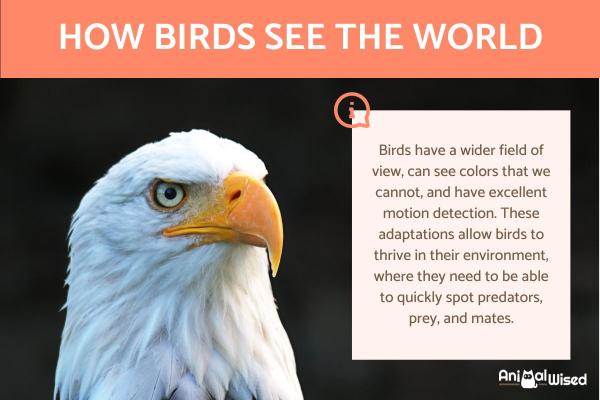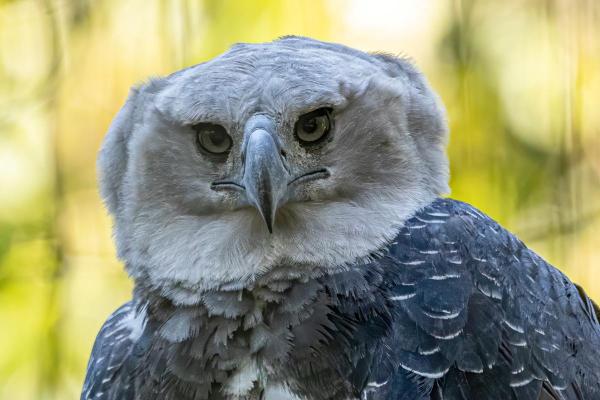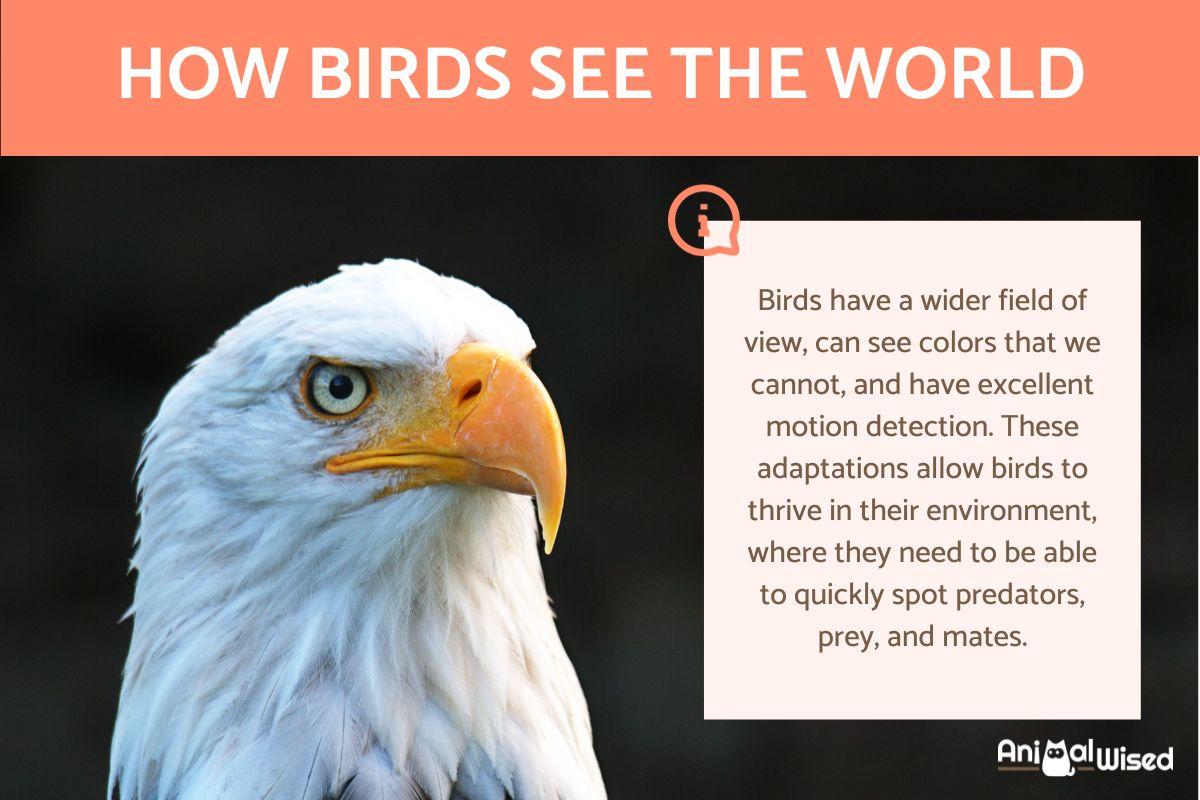How Do Birds See the World?


Have you ever wondered how birds see the world? It's quite different from how we see it. Birds have a number of unique adaptations that give them superior vision in many ways, and that allows them to see the world in all of its richness and complexity.
In this AnimalWised article, we will take an in-depth look at the amazing world of bird vision. We will explore how birds' field of vision, color perception, and eye anatomy allow them to see the world in a way that is very different from how we do.
Bird eye anatomy
Bird eye anatomy is highly specialized to meet their needs in flight, foraging, and communication. Their eyes are relatively large compared to their head size, and they are located on the sides of their head, which gives them a wide field of view.
Bird eyes have several unique features that distinguish them from mammalian eyes. One of the most notable is the presence of a pecten, a comb-like structure that projects from the back of the eye into the vitreous humor. The pecten is highly vascularized and helps to nourish the retina.
Another unique feature of bird eyes is the presence of four photoreceptor cones, rather than the three found in mammalian eyes. This allows birds to see a wider range of colors, including ultraviolet light.
Bird eyes also have a very high density of photoreceptor cells, which gives them excellent vision. In addition, their eyes are able to focus very quickly, which is essential for tracking prey in flight.
Here is a more detailed overview of the main parts of the bird eye:
- Cornea: the cornea is the transparent front part of the eye. It helps to focus light and protect the inner parts of the eye.
- Iris: the iris is the colored part of the eye. It controls the amount of light that enters the eye by adjusting the size of the pupil.
- Pupil: is the black opening in the center of the iris. It allows light to enter the eye and reach the retina.
- Lens: is a transparent structure that helps to focus light onto the retina.
- Vitreous humor: is a gel-like substance that fills the space between the lens and the retina. It helps to protect the retina and keep it in place.
- Retina: is the light-sensitive tissue at the back of the eye. It contains photoreceptor cells that convert light into electrical signals that are sent to the brain.
- Pecten: is a comb-like structure that projects from the back of the eye into the vitreous humor. It helps to nourish the retina.
- Tapetum lucidum: is a reflective layer of tissue at the back of the eye that reflects light back through the retina.

What is bird vision like?
Bird vision is extraordinary and highly specialized to meet their needs in flight, foraging, and communication. Here are some of the key features of bird vision:
- Binocular vision: many birds have significant binocular vision due to the arrangement of their eyes on the front of their heads. This allows them to partially overlap the images they see with each eye and perceive depth and distances more accurately. This vision is essential for hunting, navigation, and flying.
- Lateral field of view: although binocular vision is important, birds also have a significant lateral field of vision, often close to 360 degrees. This allows them to detect prey or predators from a wide range of angles without having to move their head.
- Color perception: many birds have excellent color perception and can see a wider range of colors than humans. Some species can even see ultraviolet colors, allowing them to detect patterns and signals invisible to us.
- Motion detection: birds' eyes are highly sensitive to motion, allowing them to detect moving prey or threats in their environment. This is especially useful for hunting birds. Birds of prey, such as hawks and eagles, have exceptionally keen vision and can detect small prey from high altitudes in flight.
- Low-light vision: some nocturnal birds, such as owls and nighthawks, have adaptations for seeing in low light conditions. This includes a high density of rods in the retina, which are sensitive to dim light.
Discover the amazing adaptations that allow birds to breathe so efficiently in this article.
How do birds see colors?
Birds see colors differently than humans do. Humans have three types of photoreceptor cones in their eyes: red, green, and blue. This allows us to see a wide range of colors, but we are unable to see ultraviolet light. Birds, on the other hand, have four types of photoreceptor cones, including an ultraviolet cone. This means that birds can see a wider range of colors than humans, including ultraviolet light.
Birds' ability to see ultraviolet light is helpful for a variety of reasons. For example, ultraviolet light can be used to detect patterns on feathers that are invisible to the human eye. This can help birds to identify mates and rivals, and to avoid predators. Ultraviolet light can also be used to find food sources, such as nectar-rich flowers and insects.
Here are some examples of how birds use their color vision:
- Hummingbirds (Trochilidae) utilize their color vision to locate flowers in flight. Many flowers exhibit ultraviolet patterns that are imperceptible to humans but are readily visible to hummingbirds.
- Male birds of Paradise (Paradisaeidae) employ their color vision to court potential mates. Their plumage is frequently adorned with vivid hues, which they use to orchestrate elaborate courtship displays aimed at captivating female Birds of Paradise.
- Hawks (Accipitridae) rely on their color vision to detect prey from a distance. They possess the ability to discern small rodents and other creatures, even when concealed within dense vegetation.
Learn more about the amazing adaptations that allow bird of paradise species to thrive in their rainforest habitat in this other article.

How do birds see at night?
Birds that are active at night, such as owls and nighthawks, have a number of adaptations that allow them to see in low light conditions. These adaptations include:
- Large eyes: nocturnal birds have large eyes, which allow them to gather more light.
- High density of rods: the retina of a nocturnal bird's eye contains a high density of rods, which are photoreceptor cells that are sensitive to dim light.
- Tapetum lucidum: many nocturnal birds have a tapetum lucidum, which is a reflective layer at the back of the eye that reflects light back through the retina. This gives the bird a second chance to absorb light and improve its vision in low light conditions.
- Tubular eye shape: the tubular shape of a nocturnal bird's eye helps to focus light onto the retina.
As a result of these adaptations, nocturnal birds are able to see very well in low light conditions. This allows them to hunt, navigate, and avoid predators at night. They are able to process visual information very efficiently and can make sense of even the smallest amount of light.
Discover how birds avoid predators and find food in the dark in this other article.
How do birds see humans?
Birds see humans in a similar way to how we see other animals. They can see our shape, size, color, and movement. However, there are some key differences in how birds see humans and other animals.
One difference is that birds can see in ultraviolet light, which we cannot. This means that they can see patterns and signals on our skin and clothing that are invisible to us.
Another difference is that birds have a much wider field of view than humans. This means that they can see us from a wider range of angles without having to move their heads.
Finally, birds have excellent motion detection. This means that they can easily spot us even if we are moving slowly or quietly.
Can birds see straight ahead?
Yes, birds can see straight ahead. They have a pair of eyes that are located on the front of their heads, which gives them binocular vision. This means that they can overlap the images from each eye to create a single, three-dimensional image. This is important for birds for a number of reasons, such as hunting, navigation, and avoiding predators.
However, birds also have a very wide field of view, which allows them to see almost all the way around them without having to move their heads. This is because their eyes are located on the sides of their heads. This is helpful for birds for avoiding predators and finding food.
Learn more about the amazing adaptations that allow carnivorous birds to be such successful hunters.

If you want to read similar articles to How Do Birds See the World?, we recommend you visit our Facts about the animal kingdom category.
- Bennett, A.T., & Cuthill, I.C. (1994). Ultraviolet vision in birds: what is its function?. Vision research , 34 (11), 1471-1478.
- Bowmaker, J. K. (1980). Color vision in birds and the role of oil droplets. Trends in Neurosciences , 3 (8), 196-199.
- Donner, K. O. (1951). The visual acuity of some passerine birds.
- Jones, M.P., Pierce Jr, K.E., & Ward, D. (2007). Avian vision: a review of form and function with special consideration to birds of prey. Journal of exotic pet medicine , 16 (2), 69-87.
- Martin, G. R. (2009). What is binocular vision for? A birds' eye view. Journal of Vision , 9 (11), 14-14.
- Zeigler, HP, & Bischof, HJ (Eds.). (1993). Vision, brain, and behavior in birds . MIT Press.








